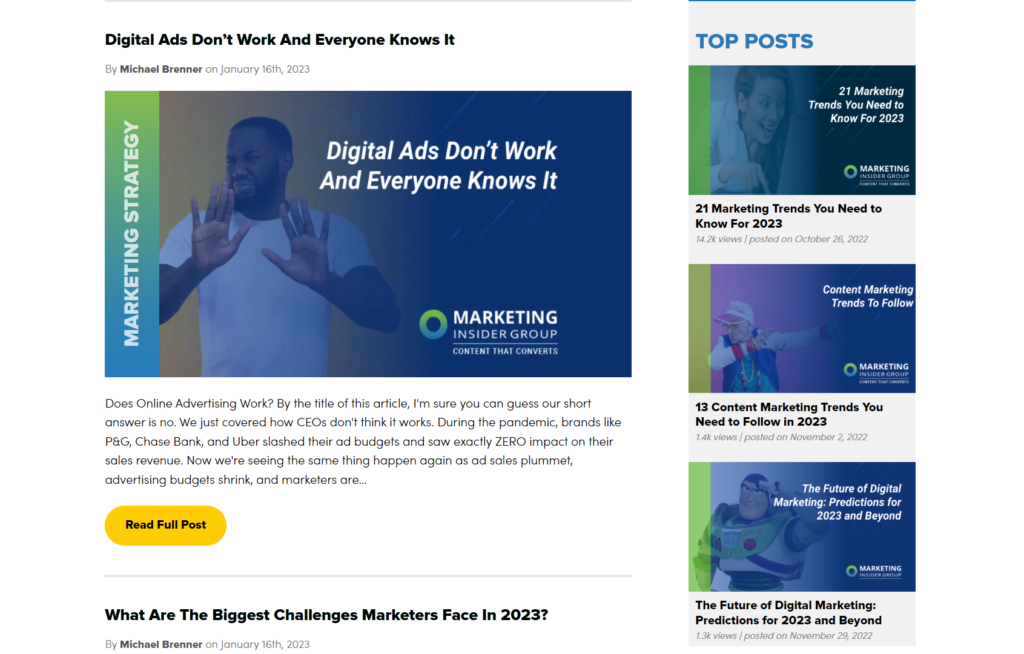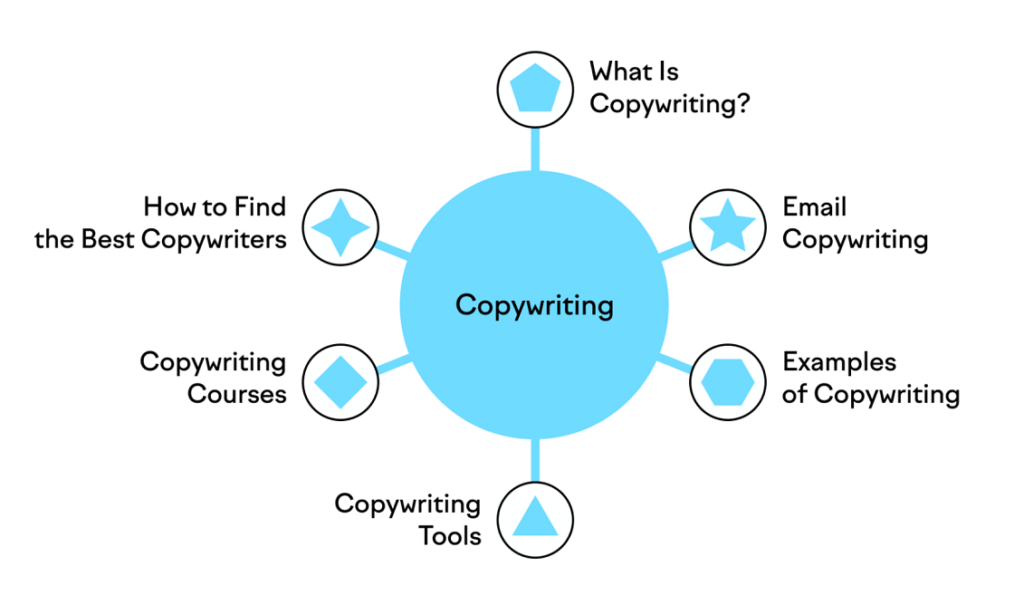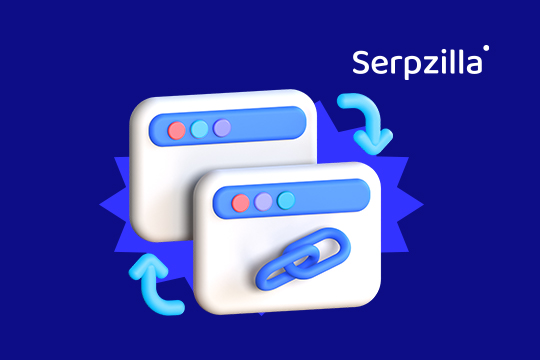Links are the currency of the internet.
As SEOs, we want links – a lot of links, high quality links.
When you think of links, the first thing that comes to mind is external links or backlinks from another site to yours. These are hard to come by. You need to work hard for them. Not only do you need excellent, helpful content on your site; you also need to build relationships with third-party site owners and have a substantial budget to spend on great link placements.
However, there is a significant source of links that lies right under your nose – one that you control. And that is internal links from your own site.
What Are Internal Links?
An “internal link” is nothing but a link from one page on your website to another.
Internal links are mainly of two types: structural and contextual.

Structural links help navigate both users and bots through the different sections of your site. They are in turn of three kinds:
- Menu: The top navigation of your site that categorizes your products, services and company information.
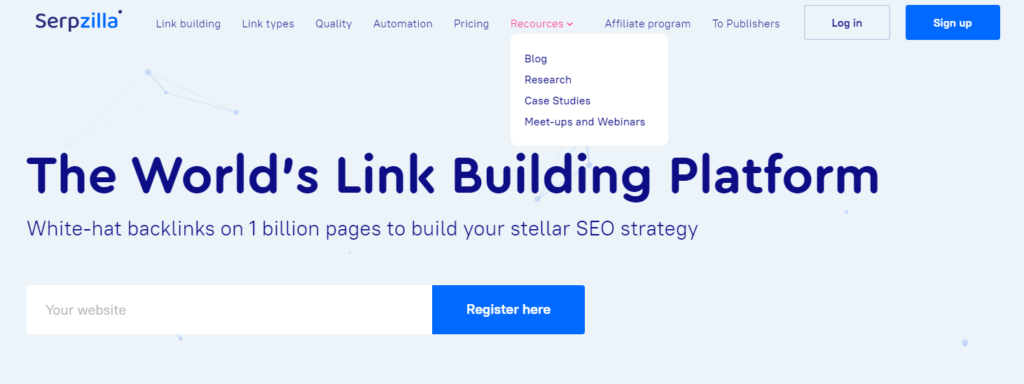
- Footer: Footer links appear at the bottom of every page and lead users to important sections and landing pages.

- Sidebar: Certain sections of your site such as blogs have a sidebar that shows additional relevant information such as blog categories and top posts.
Contextual links are manually set within the content – whether it’s web page copy or blog posts – that lead to a page with content that is relevant to what the visitor is reading right now. Contextual links also give Googlebot additional associative information to that specific topic.

Now you know what are internal links, the question arises: Why should you build them in the first place?
Why Are Internal Links Important?
There are three essential steps by which any site gains visibility on search engines: crawling, indexation, ranking.
Ideally, you want new pages to be crawled, indexed and ranked as soon as they’re published. Internal links help smooth out this process in two critical ways:
1. Discovery and crawling: Internal links (the ones related to navigation) leave a trail of breadcrumbs that tell Googlebot more about the structure of the site. They guide it from the home page to a category page or main page of a section to all the individual pages under each section.
2. Priority of indexation and authority: Naturally, you don’t want just one or two pages of your site to do well – you want your entire site to receive all the qualified traffic they can. Internal links are critical in distributing the PageRank (ranking ability) or “power” or “authority” – call it what you will – from a few pages that are doing well to new pages, or in fact all the pages that you want to promote.
John Mueller of Google has emphasized the importance of internal linking in no uncertain terms. Here’s what he had to say in a Google “SEO office hours” hangout:
“Internal linking is super critical for SEO.
I think it’s one of the biggest things that you can do on a website to kind of guide Google and guide visitors to the pages that you think are important.
And what you think is important is totally up to you. You can decide to make things important where you earn the most money or you can make things important where you’re the strongest competitor or maybe you’re the weakest competitor.
With internal linking you can really kind of focus things on those directions and those parts of your site. You should look at it in a strategic way and think about what do you care about the most and how can you highlight that with your internal linking.”
A Strategic Approach to Internal Linking
As John Mueller affirmed, strategy is paramount when it comes to internal linking. Every internal link you add must be well thought-out and contribute towards one of the following outcomes:
- Make the structure of your site clear to Google.
- Help users navigate to where they want or where you want them to.
- Pass informational value, PageRank and authority to a page.
- Add relevance to the target page.
- Help Google establish the relationship between two pages.
If you closely look at the above-mentioned points, it will strike you that content is what makes each outcome possible; it is what adds value and relevance to internal links.
Create content hubs
Most informational sites today are built with a hub-and-spoke content structure. Usually, you’ll have a few core topics you focus on (that will give you your primary keywords) and then expand on that “hub” with additional content that drills down into one particular sub-topic (from where you get your secondary or long tail keywords).
In ecommerce sites, it is easy to visualize this – you’ll have different categories of products, and then you’ll have various sub-categories, and finally individual products. The internal linking structure simply flows down to the product pages. Contextual links are built from one product page to another that you wish to upsell or cross-sell.
Similarly, if you have a blog, you build structural links down from the main blog page to categories to blog posts. Your blog home page references the categories as well as the latest articles you publish. Similarly, the category pages list out the latest article published in that category. Further, individual article pages or blog posts link to other (related or recommended) articles, the top posts of the blog, and key downloadable resources.
It’s important to note that the articles at the bottom of the structure link upwards to their category page as well as the main blog page. Basically, internal linking makes the whole blog a two-way reference – top-down as well as bottom-up.
The way to organize the information on your site with internal linking is to start with a mind map or hierarchical structure of themes, categories and topics.
Then go on to build “topic clusters” – decide what your “cornerstone” content or “pillar” content is and create supplementary articles for every theme or idea that you can think of around that topic. Link both ways from these hubs and spokes. Link between spokes too.
Add context to the content
You know the importance of context from your external link building strategies. Just like external links, the number and quality of your internal links matters a lot. When you purchase backlinks using a tool such as Serpzilla, you select the various metrics that lend authority and relevance to each link.
Internal links share the same logic with backlinks for adding context and increasing relevance. For example, if you’re an agency and creating a guide on link building, then you’d link out to your case studies as well as related topics such as digital PR. Linking to more information or landing pages will take your audience one step closer to conversion.
While this is simple to say, it isn’t very easy to do manually, especially if your blog is run by a large team and no single person has had historical control or knows all your posts inside out.
One simple trick is to get Google to help you quickly determine what posts you already have on the topic you’re writing and which ones are ripe for linking. And that is to use the site: search parameter. When you’re writing a new post, type
your keyword site: yoursite.com
in the Google search box and see what URLs are thrown up by the SERP. Then link to them using appropriate anchor text variations. Also link to your new post from the existing ones using the right anchor text to solidify the relationship.
Here’s an example from our friends at Marketing Insider Group:
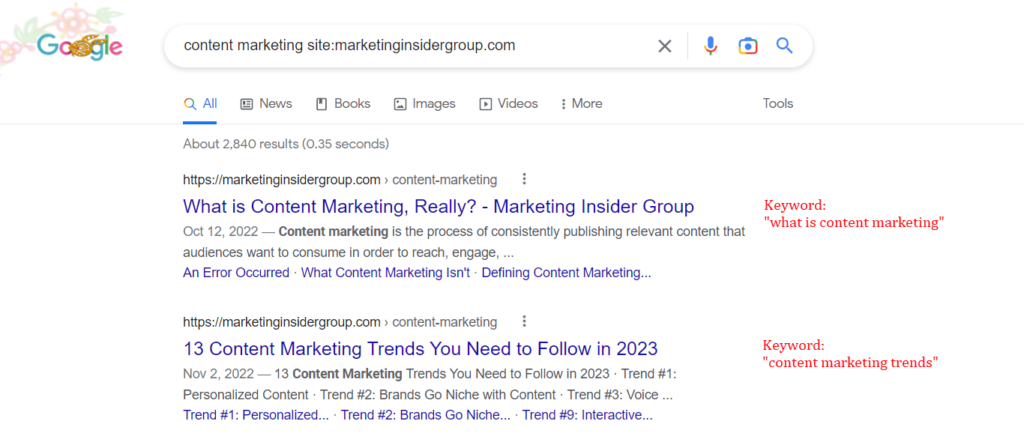
This strategy gets your new posts indexed as fast as possible while adding to your existing posts’ authority as well as the number of keywords they rank for.
Dos and Dont’s of Internal Linking
Here are some smart tactics and best practices to bear in mind while adding internal links (dos):
- Make sure all pages on your site can be reached within 3 clicks from your home page. Your need to tweak your site structure and internal links accordingly.
- Have a set of articles or landing pages that you’re always focusing on. Link to to these pages from all new content that you add to the site.
- Reserve link placements on your home page, sidebars, menu or footer for new articles or pages that you want Google to index quickly.
- Conduct regular internal link audits just like you do for backlinks. Use SEO tools like Ahrefs or Semrush or even WordPress plugins to scan your website for broken links. Replace these as soon as possible with relevant URLs.
- If your site is old, make sure you’ve converted all your URLs to HTTPS. Leaving http:// URLs in your links will make those pages lose rankings as well as give a poor experience to your users.
- Use standard HTML to define your links. Encapsulating links in JavaScript or plugins might render them uncrawlable or devalued depending on how they’re parsed by the search engine.
There are also some pitfalls you need to be wary of while linking out internally (don’ts):
- Never build links link haphazardly. Finalize your information flow and site structure before you start building internal links.
- Don’t have too many links on a page. In addition to looking spammy to users, a negligible amount of link juice will flow on to the target pages. Further, Googlebot will be stuck on that page forever, trying to crawl all of the links. Moz reported that search engines have a limit of about 150 links that they follow from a single page, so use that number as a rule of thumb.
- Don’t use the “nofollow” or “sponsored” attributes for internal links.
- Don’t have internal pages open in a new tab on the browser. That practice is for external links, so that the user doesn’t leave your site. Here, you actually want the user to move on to another page of your choosing.
- Don’t use a tool that automates internal linking. These tools add too many links on a page without understanding which pages actually need the juice and which need to conserve them. Plus, the anchor text they use can be too repetitive, limited or downright spammy.
Boost your SEO results! Link building has become fast and easy with Serpzilla. Buy quality backlinks on authority websites with high DR.

Sculpt Your Links!
You know best which pages on your site need more love from Google, which ones are lagging, and which ones can be ranked higher with a little push. Use this information and the tactics you’ve learned in this post to craft your internal links to perfection.
The right internal linking strategy will move your content up in the SERPs for more and more keywords as you produce more content.

